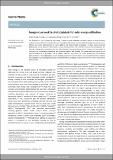Inorganic perovskite photocatalysts for solar energy utilization
View/
Date
07/11/2016Grant ID
EP/K015540/1
EP/K036769/1
NA140077
WRMA 2012/R2
Metadata
Show full item recordAbstract
The development and utilization of solar energy in environmental remediation and water splitting is being intensively studied worldwide. During the past few decades, tremendous efforts have been devoted to developing non-toxic, low-cost, efficient and stable photocatalysts for water splitting and environmental remediation. To date, several hundreds of photocatalysts mainly based on metal oxides, sulfides and (oxy)nitrides with different structures and compositions have been reported. Among them, perovskite oxides and their derivatives (layered perovskite oxides) comprise a large family of semiconductor photocatalysts because of their structural simplicity and flexibility. This review specifically focuses on the general background of perovskite and its related materials, summarizes the recent development of perovskite photocatalysts and their applications in water splitting and environmental remediation, discusses the theoretical modelling and calculation of perovskite photocatalysts and presents the key challenges and perspectives on the research of perovskite photocatalysts.
Citation
Zhang , G , Liu , G , Wang , L & Irvine , J T S 2016 , ' Inorganic perovskite photocatalysts for solar energy utilization ' , Chemical Society Reviews , vol. 45 , no. 21 , pp. 5951-5984 . https://doi.org/10.1039/C5CS00769K
Publication
Chemical Society Reviews
Status
Peer reviewed
ISSN
0306-0012Type
Journal item
Description
The authors acknowledge funding from the Engineering and Physical Research Council for research award EP/K036769/1 and Platform Grant EP/K015540/1. Financial support from the Major Basic Research Program, Ministry of Science and Technology of China (2014CB239401) and the NSFC (51422210, 51629201) is acknowledged. The authors also acknowledge support from The Royal Society Newton Fellowship, NA140077 and The Royal Society Wolfson Merit Award, WRM 2012/R2.Collections
Items in the St Andrews Research Repository are protected by copyright, with all rights reserved, unless otherwise indicated.

